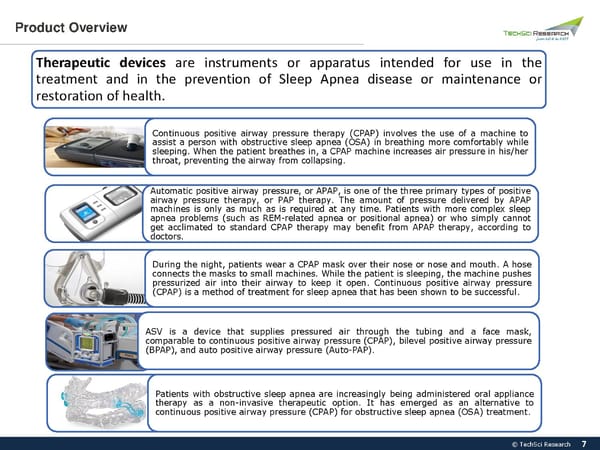Product Overview Therapeutic devices are instruments or apparatus intended for use in the treatment and in the prevention of Sleep Apnea disease or maintenance or restoration of health. Continuous positive airway pressure therapy (CPAP) involves the use of a machine to assist a person with obstructive sleep apnea (OSA) in breathing more comfortably while sleeping. When the patient breathes in, a CPAP machine increases air pressure in his/her throat, preventing the airway from collapsing. Automatic positive airway pressure, or APAP, is one of the three primary types of positive airway pressure therapy, or PAP therapy. The amount of pressure delivered by APAP machines is only as much as is required at any time. Patients with more complex sleep apnea problems (such as REM-related apnea or positional apnea) or who simply cannot get acclimated to standard CPAP therapy may benefit from APAP therapy, according to doctors. During the night, patients wear a CPAP mask over their nose or nose and mouth. A hose connects the masks to small machines. While the patient is sleeping, the machine pushes pressurized air into their airway to keep it open. Continuous positive airway pressure (CPAP) is a method of treatment for sleep apnea that has been shown to be successful. ASV is a device that supplies pressured air through the tubing and a face mask, comparable to continuous positive airway pressure (CPAP), bilevel positive airway pressure (BPAP), and auto positive airway pressure (Auto-PAP). Patients with obstructive sleep apnea are increasingly being administered oral appliance therapy as a non-invasive therapeutic option. It has emerged as an alternative to continuous positive airway pressure (CPAP) for obstructive sleep apnea (OSA) treatment. © TechSci Research 7 7
 India Sleep Apnea Devices Market, Forecast 2027 Page 6 Page 8
India Sleep Apnea Devices Market, Forecast 2027 Page 6 Page 8